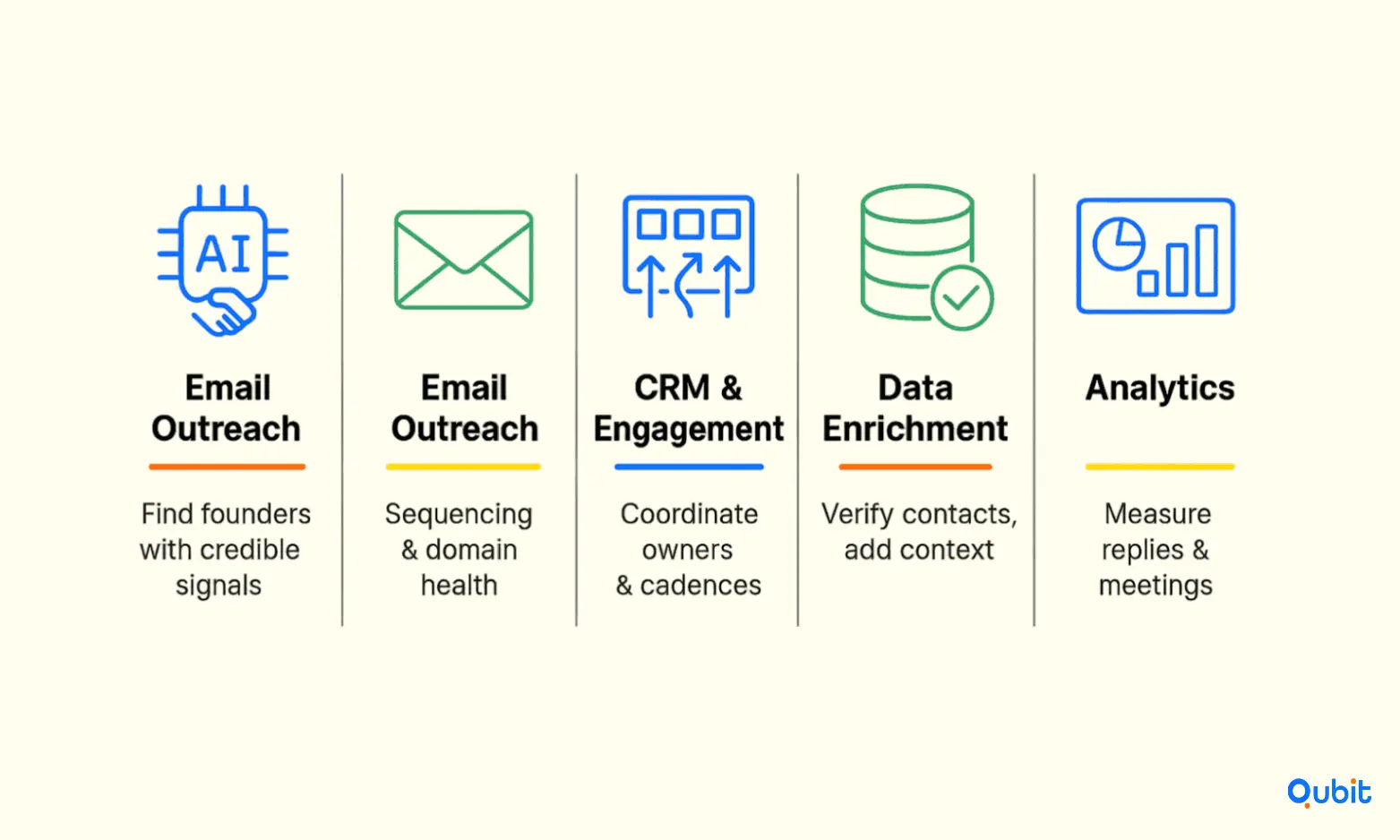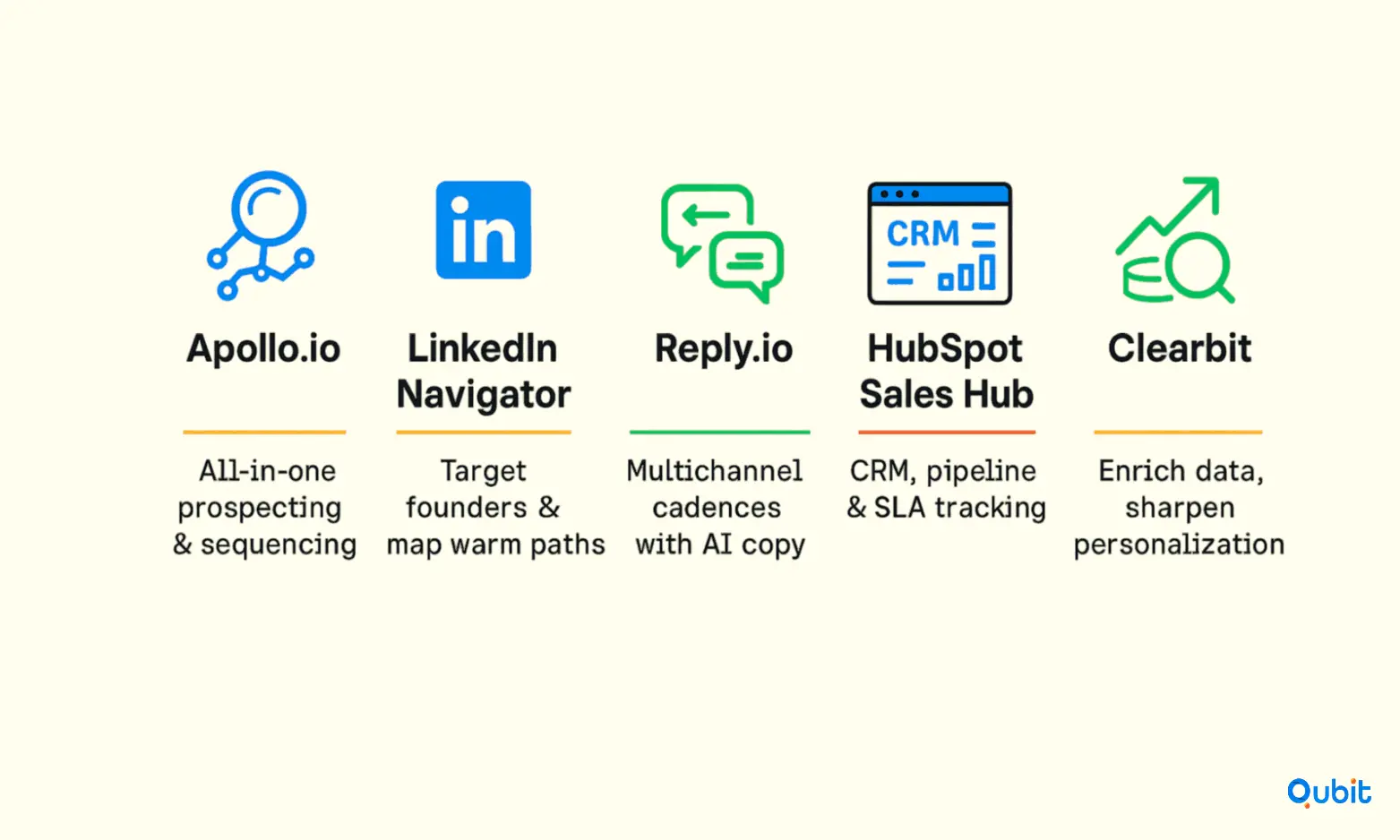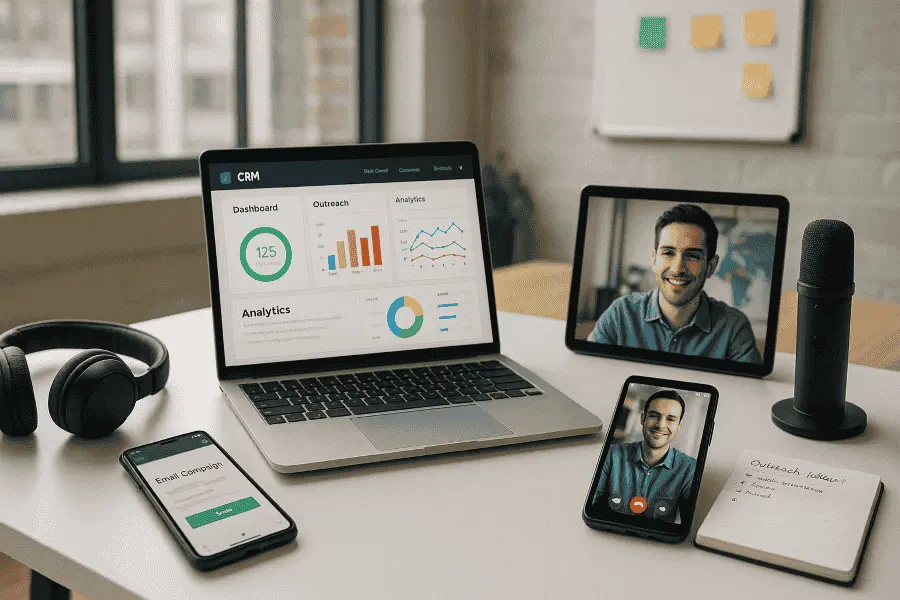Modern startup outreach is a systems problem: identify on-thesis founders, personalize at scale, route conversations into structured next steps, and measure what reliably converts attention into qualified meetings. AI-driven prospecting, multichannel sequences, and tight CRM loops help investors run this system efficiently while preserving the founder-first experience.
The right stack reduces manual research, improves deliverability and personalization, and creates clear attribution from content to conversation to diligence. For a full overview of how tools roll up into an outreach operating model, from thesis to channels to sequencing, see the broader playbook in the startup outreach guide.
In this article you will learn about the tools that would help you outreach the correct startup.
Let's get started!
Core Categories in a Startup Outreach Stack
A durable investor outreach engine typically spans five categories: AI prospecting and discovery, email outreach and deliverability, CRM and engagement orchestration, data enrichment and verification, and analytics with campaign and pipeline performance dashboards. AI prospecting surfaces founders with credible signals of fit, recent product launches, hiring bursts in defined functions, compliance milestones, partnerships, or repos, so the first touch can be specific and useful.
Outreach and deliverability platforms handle sequencing and domain health, allowing carefully ramped volume without getting flagged. CRM and sales engagement tools coordinate owners, cadences, and notes, ensuring that investor office hours, reverse pitches, and follow-ups move through defined stages. Enrichment and verification keep contact data accurate and augment messages with context that proves you did the work. Analytics completes the loop, identifying which narratives, formats, and channels generate qualified replies and meetings rather than vanity clicks.

How these categories interact in practice
A typical week might start with AI prospecting to queue on-thesis founders based on public signals, followed by enrichment and verification to confirm contacts and reduce bounces. Outreach sequences launch with two or three touches over 10–14 days, then CRM workflows assign owners and SLAs for replies and meetings.
Dashboards track qualified replies, booked meetings, and conversion to diligence, prompting small, weekly improvements to copy, targeting, and timing. That rhythm compounds into a predictable sourcing engine that respects founder time while maintaining a professional, measurable process.
AI Prospecting and Discovery
AI-native prospecting platforms are now central to the investor toolkit because they turn unstructured, public signals into actionable shortlists aligned to a thesis. The goal isn’t to outsource judgment but to compress research so investors spend time crafting context-rich outreach and building relationships. The strongest tools combine entity resolution (accurate company and contact identification), fit and intent signals (sector, stage, hiring, product milestones), and lightweight personalization scaffolding that pulls in concrete references founders recognize.
A practical approach begins with a crisp founder profile: sector/vertical, stage and traction markers, geography, and qualifiers like security posture, regulated buyer exposure, or go-to-market model. Feed that profile into the AI engine to generate candidate lists, but never launch sequences blindly. Skim for the few recent, credible signals to reference in first-touch emails and discard marginal fits early. This keeps volume humane and reply rates high. Investors focused on deep tech or regulated markets benefit most, since the signals—standards participation, grant activity, certifications—are often scattered across niche sources that AI can aggregate faster than manual research.
Where AI helps but must be constrained is personalization at scale. Use it to assemble a factual scaffold, latest release notes, a notable integration, or a thread the founder posted about a problem they’re solving, then write a short, human-first note that offers specific help. This avoids the uncanny valley of template-heavy outreach while preserving speed. Discover how AI can surface high-fit founders by exploring AI-powered prospecting approaches tailored for startup investors.
Email Outreach Automation and Deliverability
Cold email remains the most reliable, scalable channel for first-touch investor outreach when done with relevance and respect. Modern platforms solve the operational details: sequence builders with conditional logic, AI-assisted drafting that suggests variants without flattening tone, warm-up networks to establish sending reputation, and inbox rotation to spread volume across authenticated accounts. Deliverability is non-negotiable; once domain reputation degrades, reply rates collapse across every program, including those unrelated to the error that triggered the penalty.
A simple, effective pattern is two or three touches over 10–14 days. The first message references a concrete founder signal and offers immediate, practical value such as a relevant customer intro, a security checklist for a specific buyer segment, or a short office-hours slot tied to their space. The second message moves the conversation forward with a different “give,” not a repetition of the first. The final message exits cleanly and routes to a lower-intensity channel like a newsletter or community invite. Always include an easy opt-out and honor it. Respect for founder time earns reputation you cannot buy. To streamline personalized email sequences and maintain deliverability, these outreach automation best practices are highly effective for investor campaigns.
Adding light multichannel steps, like a LinkedIn connection request with a thoughtful note or a single call in enterprise-heavy contexts, can help in segments where email alone underperforms. Keep channel diversity purposeful: if a step doesn’t add new context, it’s noise. Monitor bounce rate, spam complaints, and reply quality weekly; pause and diagnose if any metric degrades rather than pushing volume harder.
CRM and Sales Engagement Orchestration
CRMs and engagement platforms serve as the connective tissue across research, outreach, meetings, and decisions. For investor use cases, the system should make it trivial to see conversation history, assign owners, and enforce SLAs so that strong replies convert into substantive meetings quickly. Cadence features and templates ensure consistency across team members, while activity logging and notes build institutional memory that improves future interactions. The right structure avoids the “lost in inbox” trap and keeps time-sensitive founder responses moving toward next steps like diligence, office hours, or a targeted reverse pitch.
A practical pipeline architecture uses stages tailored to investor operations: researched, queued for outreach, contacted, qualified reply, meeting booked, diligence, pass with feedback, and keep-warm. Each stage should have a clear definition, an owner, and a default next action. The CRM should also store artifacts that streamline future decisions: the founder’s one-pager, key metrics snapshots, meeting notes, and a decision memo when appropriate. This institutionalizes learning and reduces reliance on memory or ad-hoc spreadsheets that fail under scale.
Data Enrichment, Verification, and Research
Enrichment and verification amplify outreach credibility by anchoring messages in accurate, current data. Verification reduces bounces and protects domain health, while firmographic and technographic data enable crisp qualification—industry, team size, stack choices, compliance posture, and buyer context. In regulated sectors, additional layers like certifications, audits, and grant histories matter for both fit and immediacy; referencing these signals shows real engagement with the founder’s world.
The right enrichment workflow is lightweight and repeatable: verify addresses, append key fields that inform personalization, and pull a handful of recent signals worth referencing. Resist the temptation to stuff outreach with every data point—select the one or two that demonstrate attention and offer relevant help. For inbound filtering, enrichment can power short forms that pre-fill context and allow founders to self-select into the right next step, saving everyone time.
Analytics and Performance Dashboards
Measurement translates activity into learning. Dashboards should move beyond surface metrics and tie narratives, channels, and sequences to qualified pipeline. Opens and clicks are directional; the signals that matter are qualified replies, meeting-booked rates, conversion to diligence, and explicit references to specific assets or events that influenced a founder to engage. Weekly reviews surface what to double down on and what to retire, turning outreach into a disciplined experimentation program rather than a volume race.
Cohort analysis by narrative and segment is especially useful. Compare reply and meeting rates for different thesis framings, value propositions, or offer types (e.g., “pilot-to-paid checklist” vs “security readiness help”). Attribute responses to the specific founder signals mentioned in messages to identify which triggers predictively drive engagement. Over time, these analytics shape targeting rules, content roadmaps, and even revisions to the investment thesis.
Comparison Table: Outreach Stack Components and What to Evaluate
| Category | What It Does | Key Features to Evaluate | Why It Matters |
|---|---|---|---|
| AI Prospecting | Identifies on-thesis founders via public signals | Accurate entity matching, fit/intent signals, personalization scaffolding | Compresses research; improves targeting precision |
| Email Outreach | Scales respectful first touches | Sequencing, AI copy assist, warm-up, inbox rotation | Maintains deliverability and consistency at volume |
| Engagement Platform | Orchestrates cadences and follow-ups | Cadences, templates, owner assignment, activity logs | Prevents drop-offs; enforces SLAs and next steps |
| Data Enrichment | Improves accuracy and context | Verification, firmographics, technographics, compliance signals | Reduces bounces; enables credible personalization |
| Analytics | Connects activity to pipeline movement | Qualified replies, meeting/diligence conversion, cohort testing | Focuses time on narratives and channels that win |
Practical Workflow: From Thesis to Qualified Meetings
Begin with a sharp founder profile anchored in the thesis, vertical, stage, geography, buyer, and compliance factors. Use AI prospecting to assemble a short, prioritized list based on recent signals like product launches, integrations, or certifications.
Run verification and add enrichment fields that support a relevant, short first-touch. Draft two or three concise messages that reference one signal and offer tangible help rather than asking for a generic call. Launch the sequence with conservative volume and warm-up protections in place.
When replies arrive, triage fast in CRM, assign owners, and keep momentum with a clear next step, an office-hours slot, a reverse pitch path, or a diligence checkpoint. Review analytics weekly, cut copy or segments that underperform, and scale those that generate qualified conversations and move to diligence within 30 days.
Data Enrichment and Verification in Practice
Enrichment earns its keep when it sharpens fit and makes messages credibly specific. Verify email addresses to protect domain reputation, then append firmographics (industry, headcount, geography), technographics (stack components, integrations), and compliance signals (standards, certifications, audits). For founders in regulated markets, referencing the right acronym at the right time, SOC 2 Type II, HITRUST, ISO 27001, signals fluency and reduces friction. Resist overloading messages with data; pull one or two salient facts into the email and keep the rest in the CRM for context during the call.
Inbound workflows also benefit from enrichment. Short founder forms that pre-fill known fields and route high-fit submissions to partner review save time for both sides. Publish a lightweight rubric to set expectations, stage, traction thresholds, ICP clarity, and any gated requirements like security posture, so founders can self-select into the right path: immediate meeting, office hours, or a keep-warm track with feedback. For tips on selecting enrichment providers and optimizing your contact data, see these data enhancement techniques for lead qualification.
Top Tools Investors Can Use for Startup Outreach

- Apollo.io- Combines prospecting, enrichment, and lightweight sequencing so small teams can run end-to-end outreach without stitching multiple tools; ideal for fast list-building and first campaigns.
- LinkedIn Sales Navigator- Precision search, alerts, and warm-path mapping that surface high-fit founders and mutual connectors; essential for thesis-led targeting and soft-intro workflows.
- Reply.io- Multichannel cadences (email, LinkedIn, dialer) with AI-assisted copy and deliverability controls; helpful for scaling short, respectful sequences and testing narrative variants.
- HubSpot Sales Hub- Integrated CRM with pipeline stages, templates, and tracking; centralizes notes, owners, and SLAs so strong replies convert quickly to meetings and diligence.
- Clearbit- Firmographic and technographic enrichment that sharpens personalization and qualification; reduces bounces and generic messaging by anchoring outreach in accurate context.
Conclusion
A high-performance startup outreach stack is less about piling on tools and more about sequencing a few capabilities that compound: AI-assisted prospecting to find thesis-fit founders, deliverability-safe outreach to earn replies, disciplined CRM motion to keep momentum, data enrichment for credible personalization, and dashboards that tie everything to meetings and diligence. Start lightweight, protect your domain, run short campaigns with clear hypotheses, and prune relentlessly based on qualified replies and conversion, not vanity metrics.
If you're ready to elevate your outreach campaigns, we can help. Let us help you transform your cold email outreach with our Investor Outreach service. Contact us today for a customized solution tailored to your goals.
Key Takeaways
- AI prospecting accelerates research and improves fit without replacing human judgment.
- Keep sequences short, value-forward, and respectful; deliverability discipline is non-negotiable.
- CRM stages, owners, and SLAs prevent momentum loss after a strong reply.
- Enrichment boosts credibility when it informs concise, specific messages.
- Measure qualified replies, meetings, and diligence—not just opens and clicks.
Frequently asked Questions
What’s the most impactful first step for upgrading an outreach stack?
Start with a deliverability-safe email platform that includes verification and warm-up, then standardize two- to three-touch sequences anchored in specific founder signals and concrete value offers.


 Back
Back



